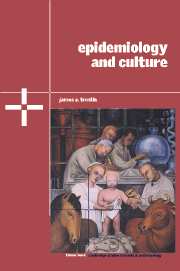Book contents
- Frontmatter
- Contents
- List of Figures and Tables
- Foreword by S. Leonard Syme
- Acknowledgments
- Epidemiology and Culture
- 1 Introduction
- 2 The Origins of an Integrated Approach in Anthropology and Epidemiology
- 3 Disease Patterns and Assumptions: Unpacking Variables
- 4 Cultural Issues in Measurement and Bias
- 5 Anthropological Contributions to the Study of Cholera
- 6 Anthropological and Epidemiological Collaboration to Help Communities Become Healthier
- 7 Perceiving and Representing Risk
- 8 Conclusion
- References
- Index
8 - Conclusion
Published online by Cambridge University Press: 05 June 2012
- Frontmatter
- Contents
- List of Figures and Tables
- Foreword by S. Leonard Syme
- Acknowledgments
- Epidemiology and Culture
- 1 Introduction
- 2 The Origins of an Integrated Approach in Anthropology and Epidemiology
- 3 Disease Patterns and Assumptions: Unpacking Variables
- 4 Cultural Issues in Measurement and Bias
- 5 Anthropological Contributions to the Study of Cholera
- 6 Anthropological and Epidemiological Collaboration to Help Communities Become Healthier
- 7 Perceiving and Representing Risk
- 8 Conclusion
- References
- Index
Summary
Diseases are strangely intimate disorders, eliciting private sensations and personal emotions. They also are achingly public experiences, especially frightening when counting makes them visible. Descriptions of disease often move back and forth between textual and statistical portrayals, between pain and hope in individuals, and between cancer rates or life expectancy in populations. For example, the public was put on notice by a Time magazine cover in 1998 that blared: “THE KILLER GERM. It's turning up everywhere: in your water, your food, the pool. How to protect yourself from E. Coli.” But the article began with this sentence: “Tammy Lowery couldn't see the blood vessels rupturing in her gut, but the way she was feeling, she didn't have to.” This sensationalized introduction mixes general menace (“turning up everywhere”) with personal exposure (“your water, your food”), and a specific person (Tammy). Journalistic accounts like this often describe sick individuals as a hook to draw their readers' attention and increase their interest; they present disease statistics to help their audience feel – and perhaps also understand – the magnitude of a health problem.
Health researchers have been far more reluctant than journalists to mix stories about sick individuals with statistics about disease patterns. Researchers tend to communicate within their own disciplines more than with others, and most have little or nothing to do with the general public. They get trained in, and rely on, a limited number of forms of knowledge exchange.
- Type
- Chapter
- Information
- Epidemiology and Culture , pp. 168 - 174Publisher: Cambridge University PressPrint publication year: 2005



